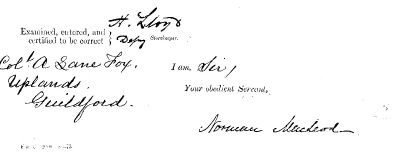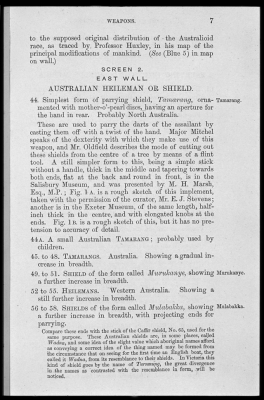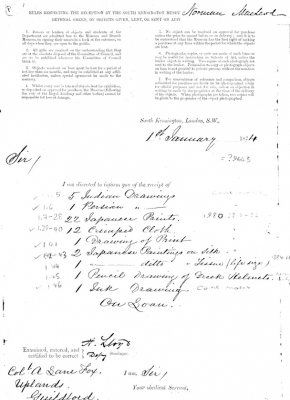Find out more about the Pitt-Rivers' collection at Bethnal Green here and here.
There were at least 23,000 objects given to the University of Oxford to found the Pitt Rivers Museum. [1] It is known that some items were taken away from the collection before it was transferred to Oxford because Pitt-Rivers wished to use them in his new museum at Farnham, Dorset (these were mainly agricultural implements etc). It is not known if any additional items were added to the collections between them being in the care of South Kensington Museum and being transferred to Oxford. Given that there is no evidence that this happened, it is probably best ignored as an option.
The logic must be, therefore, that the displays at South Kensington Museum in 1884 must have contained at least 23,000 objects, though the documentation suggests that people thought there were about 14,000.
This page attempts to look at what, where and when for the Pitt-Rivers' loaned objects associated with Bethnal Green and South Kensington Museums.
1877/ 1879 Parts I and II Catalogue
The catalogue Lane Fox published in 1877 to accompany the Bethnal Green Museum displays (and reprinted shortly after the collection was moved to the main museum in South Kensington) lists 1247 objects of which almost all are weapons. This was Parts 1 and 2 of the comprehensive catalogue that he meant to write further instalments of, to cover other displays, but which were never completed. According to the frontispiece to the 1879 edition:
'The portion of the Catalogue treated of in the Catalogue already published (Parts I and II) has been arranged, as far as the building will allow, in the same order as before. It begins with Case I (Typical Human Skulls, etc.,) which will be found by the Queen's Gate Entrance at the north end of Room L. The screens begin with No 2 on the EAST Wall of this room, and follow in consecutive order, bearing the same numbers as in the Catalogue to No. 39 in the adjoining room (K). ...
Page vii: Parts III and IV will be published hereafter, and will relate, the former to modes of navigation, representative arts of savage and early races, ornamentation, personal ornaments, pottery and substitutes for pottery, tools, deities, and religious emblems, clothing and weaving, fire-arms, and Illustrations of the modes of hafting stone implements. Part IV, will be devoted to the pre-historic series, and will include natural forms, simulating artificial forms, illustrations of forgeries and modern fabrications, palaeolithic implements, neolithic implements, bronze implements, and iron implements, with the stone implements of modern savages, adapted to the illustration of those of pre-historic times.
Given that the contents of Parts I and II and the proposed contents of Parts III and IV did not change between 1877 and 1879,it is inferred that these displays must have existed from 1874. As far as Parts I and II are concerned, the catalogue entries for each artefact have been matched to the relevant objects in the founding collection so that it is possible to show that which specific objects were arranged into the series, were displayed at Bethnal Green Museum from 1874, and transferred to South Kensington Museum in late 1878, remaining there until 1885 when they were transferred to Oxford. Because the other displays were not catalogued it is not possible to be so clear which objects were present between 1874 and 1885.
It is strange that the bulk of the objects that comprised the Bethnal Green displays are not listed anywhere (that has been found to date). Given the bureaucracy which the South Kensington Museum authorities followed for smaller loans from Pitt-Rivers that came in between 1874 and 1884, it is curious that they did not follow a similar procedure for the biggest portion of the loan. Apart from the 1247 entries listed in Parts I and II of the catalogue (which actually equate to 1636 separate artefacts), there are a further 4807 entries in the founding collection documentation (equating to 5567 separate artefacts) which have four-figure numbers which suggest that they must have formed part of the original displays. If this supposition is correct then it might be inferred that the original large loan from Lane Fox comprised of some 7203 artefacts. However, some of these are listed in the green book (see below) and in order not to double-count the objects it might be safer to assume that there were 1247 objects in the catalogue and 4656 other objects in the original displays (items with four-figure numbers minus those listed in the green book) making a conjected total of 5903.
The supposition is made because the four figure numbers seem to be a continuation of the 1-1274 numbers used in Parts I to II of the catalogue. An object with this sort of number is not usually associated with an Ag or fraction number.
South Kensington Museum's Day book entries, the so-called 'Green book'
It is known that between 1874 and 1884 the South Kensington Museum authorities accepted a large number of additional objects on loan, these are listed in the book that the Pitt Rivers Museum calls the 'Green book'. This is a book of photocopies of sheets of paper signed by members of South Kensington Museum staff and dating from 1 January 1874 to 22 July 1884. Each page lists a series of objects received on that day on loan from Lane Fox / Pitt-Rivers.
The first page is typical and is shown here. For ease of reference here are the typed and written contents of the page. Latter versions of the page are headed 'Science and Art Department of the Committee of Council on Education', this one is not but the heading is probably applicable:
[Printed]
January 1873 No 70a
Rules respecting the reception by the South Kensington Museum, and its branch museum at Bethnal Green, of objects given, lent, or sent on approval for purchase

2. All gifts are received on the understanding that they are at the absolute disposal of the Committee of Council, and are to be exhibited wherever the Committee of Council think fit.
3. Objects received on loan must be lent for a period of not less than six months, and may be exhibited at any affiliated institution, unless special agreement be made to the contrary.
4. Whilst every care is taken of objects lent for exhibition, or deposited on approval for purchase, the Museum (following the rule of the Royal Academy and other bodies) cannot be responsible for loss or damage.
5. No object can be received on approval for purchase unless the price be named before or on delivery; and it is to be understood that the Museum has the first right of making a purchase at any time during the period for which the objects are lent.
6. Photographs, copies, or casts are made of such loans as may be useful for instruction in Schools of Art, unless the lender object in writing. Two copies of each photograph are sent to the lender. Permission to copy or photograph objects on loan is not granted to private persons without the sanction in writing of the lender.
7. For convenience of reference and comparison, objects submitted for purchase are liable to be photographed solely for official purposes and not for sale, unless an objection in writing be made by the proprietor at the time of the delivery of the objects. When photographs are taken, two copies will be given to the proprietor of the object photographed.
South Kensington, London, S.W.,
[handwritten] 1st January [Printed] 187 [handwritten] 4
[handwritten] Sir/
[Printed] I am directed to inform you of the receipt of
[Handwritten] 5 Indian Drawings
1 Persian ,,
22 Japanese Prints
12 Crimped Cloth
1 Drawing of Print
2 Japanese Paintings on Silk
1 ,, ditto ,, Tissue (life size)
1 Pencil drawing of Greek helmets
1 Suk drawing
On loan
[Printed] Examined, entered, and certified to be correct [Handwrittten] H. Lloyd Depy [sic, Deputy] [Printed] Storekeeper
[Handwritten] Col.l A Lane Fox
Upland
Guildford
[Printed] I am [Handwritten] Sir,
[Printed] Your obedient Servant,
[Handwritten] Norman MacLeod
[Printed] F & T 2000 8-73
The form remained the same until the last sheet was completed on 22 July 1884 except the printed decade was updated, and at the end was printed
'and to state that a further communication will be sent to you in due course'.
This last entry was signed by an illegible signature (possibly Doswell) and below is printed 'Colonel, R.E., Assistant Secretary' with the Assistant struck out by pen. By this time the final number (possibly the number of the form) had changed to 'R & S (11,072) 250 12-83'.
The other markings that you can see on the illustration were made by the author when she was matching specific entries to objects in the founding collection, during the first Leverhulme Trust-funded Pitt Rivers project
A total of 7885 objects are listed in the green book, which seems to imply that the total number of objects displayed at Bethnal Green and South Kensington Museum is 13788 [5903 (listed in the catalogue or given further four-figure numbers, not listed in the green book) + 7885], very close to the total of 14,000 that other commentators said that the Pitt-Rivers first collection comprised.
Less than 20 objects listed in the 1877 catalogue are also listed in the Green Book. They are all entered on very early pages of the Green Book with early dates which suggest that they were added to the displays very early on and included in the catalogue.
Most of the entries in the Green book are associated with Ag. [Aggregate or agenda] numbers or fraction numbers. For a long time the meaning of these figures (which are recorded on the objects) was more or less unknown. Beatrice Blackwood suggested in Origin and Development that Ag stood for Aggregation - that is, sum or total. The green book entries made it clear that objects with the same date were often given the same Ag number. At the beginning of the Green book the objects are always associated with Ag numbers. Later on (after page 120 for entries dated 29.9.1879) this changes to dates being linked with specific ends of fraction numbers. I think that the 'Ag' numbers and fraction numbers are part of the same series: the fraction numbers clearly follow on from the Ag numbers which also increased over time.
The first entry in the green book specifically associated with an Ag number is on page 3 [dated 14.2.1874] which is associated with Ag 122. From there the numbers increase with each receipt [and over time] to a top Ag number of 9974 [page 119 dated 15.9.1879] the first fraction number starts on page 120 with 10010 [dated 29 September 1879]. It seems likely that the fraction numbers are some sequential count of objects
The first part of the fraction refers to the number of objects that have been listed against the second part of the fraction number. For example, object number 1/12395 is the first object to be matched against the denominator 12395. There are a total of 69 objects with this denominator, so the last has the number 69/12395.
However, there are also objects which have not yet been accessioned by the Pitt Rivers Museum but are listed in various forms of documentation as having been part of the founding collection. Some of these can be matched to either 1877 catalogue entries or green book entries. There appears to be one entry -- not yet accessioned by the Pitt Rivers Museum -- which appears in both the green book and in the 1877 catalogue; this is listed as 672 in the 1877 catalogue. The number is so high mostly because of the physical anthropology specimens from Part I, which do not appear to have been transferred, or were perhaps retained after transfer in the Oxford University Museum of Natural History. There are 1058 entries that cannot be matched to items currently known to have been part of the founding collection and accessioned by the PRM, these equate to 5889 objects. This gives then a total of all possible objects in the Bethnal Green and South Kensington Museum displays of nearly 21,000 objects, or quite close to the sort of total that the Pitt Rivers Museum now think the founding collection might reach once all the items are retrieved and accessioned.
It is not known who started the frankly odd numbering system used in the Green Book or whether it was standardly employed for South Kensington Museum loans between 1874-1884.
Bibliography for this article
Blackwood, B. 1970. The classification of artefacts in the Pitt Rivers Museum Oxford. Occasional Papers on Technology no. 11 Pitt Rivers Museum, Oxford
Fox, A.H. Lane 1877. Catalogue of the Anthropological Collection lent by Colonel Lane Fox for exhibition in the Bethnal Green branch of the South Kensington Museum June 1874 Parts I and II. London, Science and Art Department of the Committee of Council on Education HMSO [Re-issued 1879]
AP, February 2011, revised February 2013
Notes
[1] 22830 as at February 2013, the total is likely to rise throughout 2013 as the Excavating Pitt-Rivers project founds more unentered items.




